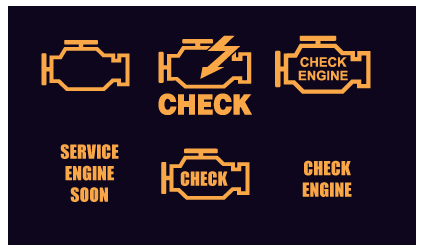Seeing a “check engine” light appear can be unnerving, but it doesn’t necessary mean something catastrophic is going wrong with your car. Modern cars and trucks include sophisticated computers that regulate and monitor a wide variety of performance issues. When anything fals outside a specified range, the “check engine” light lets you know; identifying and dealing with the particular issue can be relatively easy.
Don’t Panic
Take the warning seriously, but don’t panic. A “check engine” light doesn’t mean you need to stop driving immediately and call for help. Especially if your car still seems perfectly normal and functional, the light may not indicate anything severely harmful. If the lights at the same time, slow down and get to a mechanic as soon as possible. When the “check engine” light is your only sign that something is wrong, you may want to check and tighten your gas cap as a first step. A loose or missing cap can easily trigger a “check engine” light.
Have Your Code Read
The “check engine” light is triggered by a car’s on-board diagnostics (OBD) system, which monitors and manages fuel efficiency and emissions. In 1996, federal law established the OBD-II regulations, which standardize basic aspects of engine diagnostics across all cars. This means that you don’t have to go t a dealership or specialized auto shop for help with your “check engine’ light. Any mechanic should easily be able to connect a portable computer to your car and read the trouble code that caused the light to come on. In fact, some auto parts stores will read the code for you as a free service or for a minimal charge.
Decide what to do next
Learning which trouble code(s) caused the problem is an essential step, but it may not lead to clear-out solution. Some “check engine” problems require a straightforward repair, but many are less black – and – white. A non-urgent trouble code may indicate a progressive problem that you should address at some point to ensure optimal engine performance and efficiency. A code could also point to the general nature of the problem without pinpointing a specific part to replace or a needed repair. OBD systems are so sensitive that a “check engine” light could also mean only that routine maintenance is required, or that you should consider using a different kind of fuel or possibly adjust certain driving habits. Once you know the code(s) behind your “check engine” light, the best way to proceed is to consult a trusted mechanic, ideally one familiar with you and your vehicle. The mechanic may simply clear out the code and tell you to keep an eye out for additional trouble, or he might advise you to go ahead and authorize a tune-up or repair. In either case, you’ll have an expert opinion to inform whatever decision you make.
f you are a vehicle enthusiast and your vehicle has some other problems, why not buy vehicle diagnostic tools from our website, and then diagnose auto malfunctions all by yourself. These vehicle diagnostic tools are: Autel MaxiDAS® DS708, Autel MaxiDiag Elite MD802, Autel MaxiSys MS 908, and so on.

Troubleshooting a Check Engine Light
by
Tags:

Leave a Reply